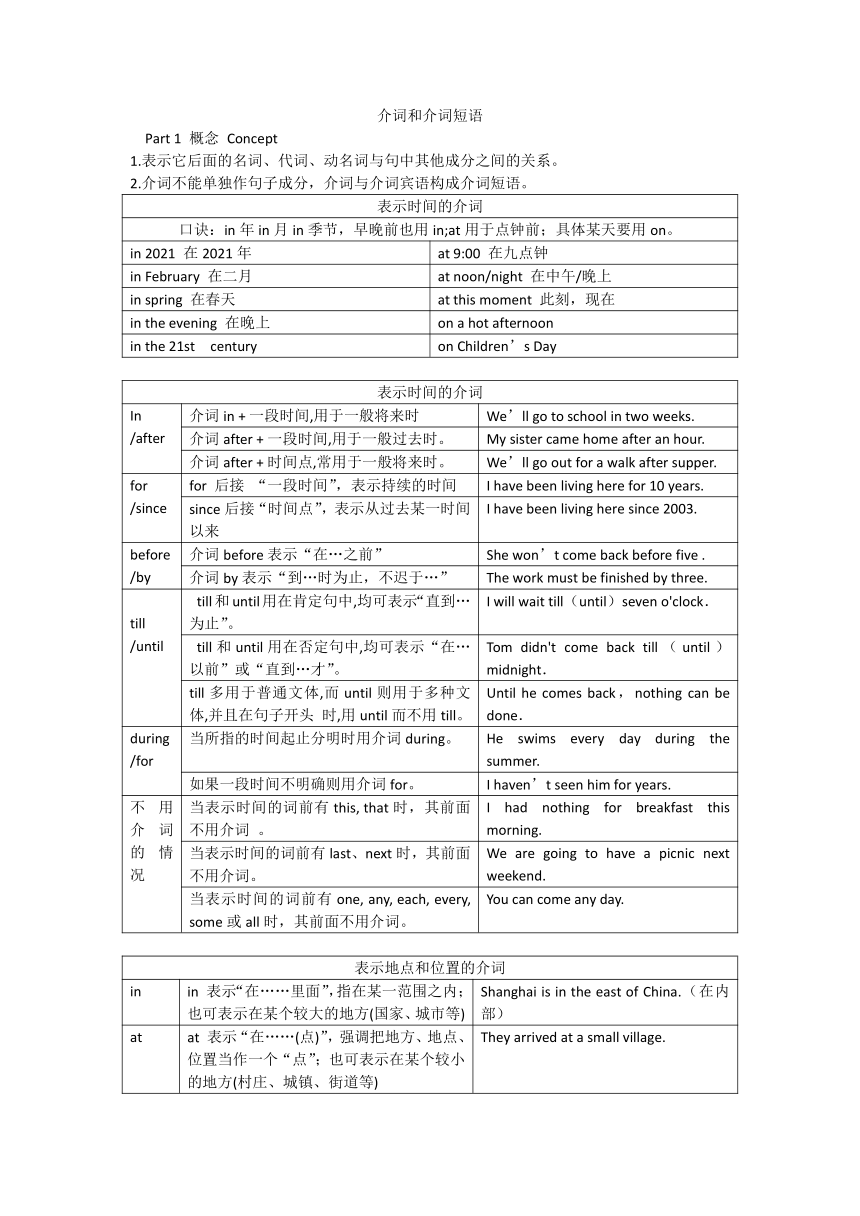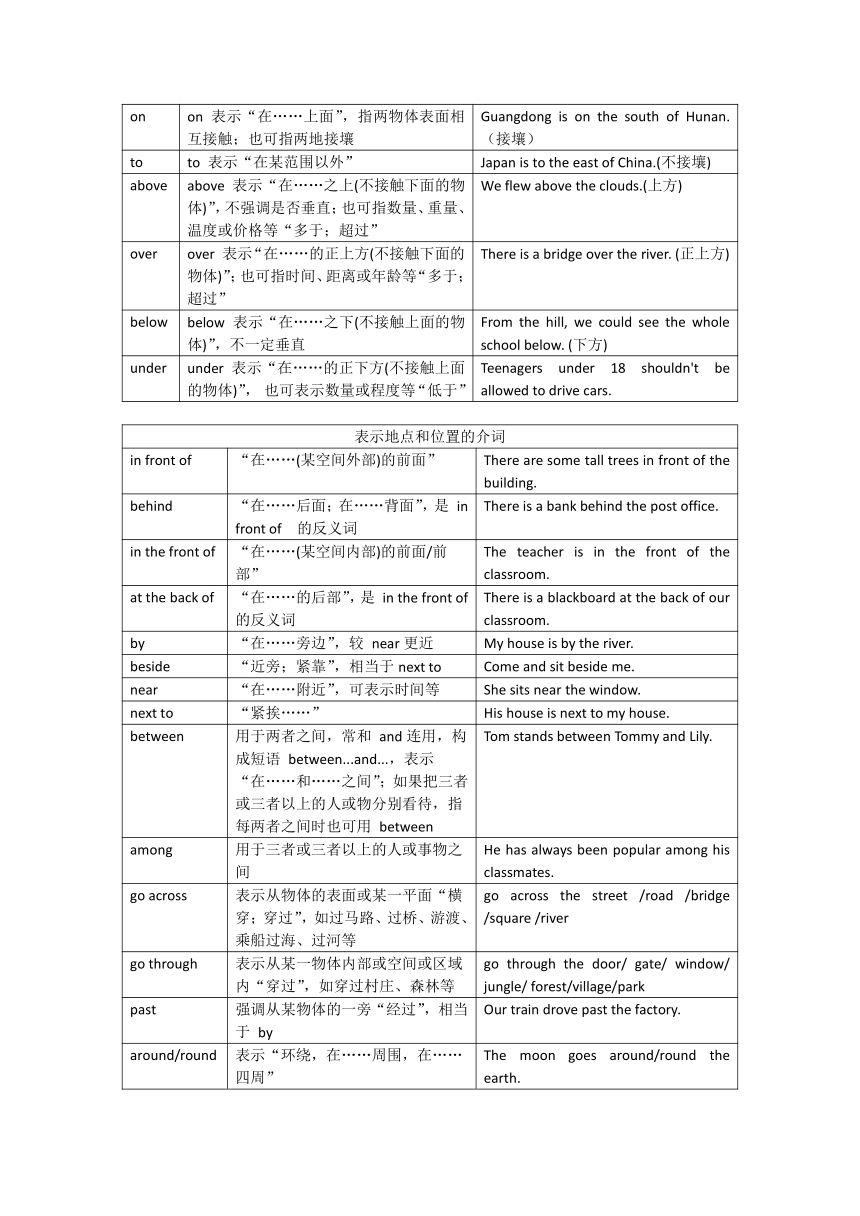2024年中考英语语法复习之介词和介词短语
文档属性
| 名称 | 2024年中考英语语法复习之介词和介词短语 |

|
|
| 格式 | docx | ||
| 文件大小 | 26.8KB | ||
| 资源类型 | 教案 | ||
| 版本资源 | 人教新目标(Go for it)版 | ||
| 科目 | 英语 | ||
| 更新时间 | 2024-04-23 16:25:14 | ||
图片预览


文档简介
介词和介词短语
Part 1 概念 Concept
1.表示它后面的名词、代词、动名词与句中其他成分之间的关系。
2.介词不能单独作句子成分,介词与介词宾语构成介词短语。
表示时间的介词
口诀:in年in月in季节,早晚前也用in;at用于点钟前;具体某天要用on。
in 2021 在2021年 at 9:00 在九点钟
in February 在二月 at noon/night 在中午/晚上
in spring 在春天 at this moment 此刻,现在
in the evening 在晚上 on a hot afternoon
in the 21st century on Children’s Day
表示时间的介词
In /after 介词in + 一段时间,用于一般将来时 We’ll go to school in two weeks.
介词after + 一段时间,用于一般过去时。 My sister came home after an hour.
介词after + 时间点,常用于一般将来时。 We’ll go out for a walk after supper.
for /since for 后接 “一段时间”,表示持续的时间 I have been living here for 10 years.
since后接“时间点”,表示从过去某一时间以来 I have been living here since 2003.
before /by 介词before表示“在…之前” She won’t come back before five .
介词by表示“到…时为止,不迟于…” The work must be finished by three.
till /until till和until用在肯定句中,均可表示“直到…为止”。 I will wait till(until)seven o'clock.
till和until用在否定句中,均可表示“在…以前”或“直到…才”。 Tom didn't come back till(until)midnight.
till多用于普通文体,而 until则用于多种文体,并且在句子开头 时,用until而不用till。 Until he comes back,nothing can be done.
during /for 当所指的时间起止分明时用介词during。 He swims every day during the summer.
如果一段时间不明确则用介词for。 I haven’t seen him for years.
不用介词的情况 当表示时间的词前有this, that时,其前面不用介词 。 I had nothing for breakfast this morning.
当表示时间的词前有last、next时,其前面不用介词。 We are going to have a picnic next weekend.
当表示时间的词前有one, any, each, every, some或all时,其前面不用介词。 You can come any day.
表示地点和位置的介词
in in 表示“在……里面”,指在某一范围之内;也可表示在某个较大的地方(国家、城市等) Shanghai is in the east of China.(在内部)
at at 表示“在……(点)”,强调把地方、地点、位置当作一个“点”;也可表示在某个较小的地方(村庄、城镇、街道等) They arrived at a small village.
on on 表示“在……上面”,指两物体表面相互接触;也可指两地接壤 Guangdong is on the south of Hunan.(接壤)
to to 表示“在某范围以外” Japan is to the east of China.(不接壤)
above above 表示“在……之上(不接触下面的物体)”,不强调是否垂直;也可指数量、重量、温度或价格等“多于;超过” We flew above the clouds.(上方)
over over 表示“在……的正上方(不接触下面的物体)”;也可指时间、距离或年龄等“多于;超过” There is a bridge over the river. (正上方)
below below 表示“在……之下(不接触上面的物体)”,不一定垂直 From the hill, we could see the whole school below. (下方)
under under 表示“在……的正下方(不接触上面的物体)”, 也可表示数量或程度等“低于” Teenagers under 18 shouldn't be allowed to drive cars.
表示地点和位置的介词
in front of “在……(某空间外部)的前面” There are some tall trees in front of the building.
behind “在……后面;在……背面”,是 in front of 的反义词 There is a bank behind the post office.
in the front of “在……(某空间内部)的前面/前部” The teacher is in the front of the classroom.
at the back of “在……的后部”,是 in the front of 的反义词 There is a blackboard at the back of our classroom.
by “在……旁边”,较 near更近 My house is by the river.
beside “近旁;紧靠”,相当于next to Come and sit beside me.
near “在……附近”,可表示时间等 She sits near the window.
next to “紧挨……” His house is next to my house.
between 用于两者之间,常和 and连用,构成短语 between...and...,表示“在……和……之间”;如果把三者或三者以上的人或物分别看待,指每两者之间时也可用 between Tom stands between Tommy and Lily.
among 用于三者或三者以上的人或事物之间 He has always been popular among his classmates.
go across 表示从物体的表面或某一平面“横穿;穿过”,如过马路、过桥、游渡、乘船过海、过河等 go across the street /road /bridge /square /river
go through 表示从某一物体内部或空间或区域内“穿过”,如穿过村庄、森林等 go through the door/ gate/ window/ jungle/ forest/village/park
past 强调从某物体的一旁“经过”,相当于 by Our train drove past the factory.
around/round 表示“环绕,在……周围,在……四周” The moon goes around/round the earth.
防坑指南 on the wall 在墙上(表示物体贴/挂在墙表面)
in the wall 在墙里面(表示物体镶嵌在其中)
in the tree 在树上(外来物栖息、停留在树上)
on the tree 在树上(树叶、果实等长在树上或其他物体固定悬挂在树枝上)
表示方式,手段或工具的介词
In 1.指用语言、话语、声音或材料等 2.后加表示颜色或服装的词表示“穿、戴”;用于小型封闭型的交通工具前,并且该名词前面有限定词 1.We write in ink. 2.Can you sing this song in English? 3.She is always in red. 4.He goes to school in a car.
on 表示用某种通讯方式、手段或使用某种开放型的交通工具且该名词前面有限定词 They talked on the phone He goes to school on a bus.
with 表示用某种工具、手段,一般接具体的、有形的工具或手段 2.表示“和……一起” 3.表示“带有……” 1.I write with a pen. 区分口诀:in材料with有形工具 I often go to school with my sister She is a girl with blonde hair.
by 表示用某种方法、手段或泛指使用某种交通工具 She makes a living by selling clothes. I go there by bus。
防坑指南:by car=in a car by plane=in a plane by bus=on a bus by bike=on a bike by boat=in a boat by train=on a train 除了 by 之外,in 和 on 也可以表示使用某种交通工具,但后两者需要使用冠词或形容词,且要注意与交通工具的搭配。
其他常见介词
beside 指“除……外,还有……”,表示加的概念。
except 指“整体中除去一部分”,表示减的概念。
but 常用于固定搭配nothing but或nobody but,表示“只有,仅有”的意思。
besides, except和but的区别: 1.We have lots of things in common besides music.除了音乐,我们还有很多共同点。 2.We go to school every day except Saturday and Sunday. 除了星期六和星期天,我们天天要上学。 There’s nobody but Tom in the classroom. 教室里只有汤姆在。
in 表示“用……”,后接语言、颜色、材料等名词,且in和后面的名词之间一般没有其他词。
with 表示“用……”,后接具体的手段与工具等名词,且with与后面的名词之间一般有其他词。
in和with表示“用”的区别: He told us a story in English. 他用英语给我们讲了一个故事。(in 后直接加语言,中间没有其他词) 2.Please color this cloth in red. 请用红色染这块布。 3.Kate wrote a letter in ink. 凯特用墨水写了这封信。 4.He hit my window with a stone. 他用一块儿石头砸了我的窗户。(with和stone中间有冠词a)
with 表示“和……一起;具有……”等意思。
without 表示“没有”等意、思,与with 相反。
with和without的区别: 1.China is a country with a long history.中国是一个有悠久历史的国家。 2.I want to go to the park with you. 我想和你一起去公园。 3.Fish will die without water. 没有水,鱼就会死。
against 意为“反对;对抗” Class Three played against Class One yesterday.昨天(三)班和(一)班进行了比赛。
into 意为“到……里”,常与动词连用,表示方向 He came into the room and rested. 他走进房间休息了。
of 意为“……的”,表示数量或种类 This is a map of the world. 这是一张世界地图。
for 意为“为;给”,表示目的 My mom bought a pen for me. 我妈妈给我买了一支钢笔。
from 意为“从”,常与 to连用 He works from morning to evening. 他从早到晚工作。
as 意为“作为”,后跟身份或职业 Mo Yan is well-known as a writer. 莫言作为作家很有名。
about 意为“有关;关于”,后跟内容 Can you talk with me about shared bikes?你能跟我谈一下共享单车吗?
beyond 表示“超出,多于,为……所不能及”,用来修饰范围、水平、限度和能力等 The problem is far beyond me.I'm afraid I can't work it out. 这道题远超我的水平,我怕我解不出来。
like 表示“像……一样”,用于说明相似关系,实际上不是;又可表示“例如” The girl looks like her father. 这个女孩长得像她父亲。
Part 1 概念 Concept
1.表示它后面的名词、代词、动名词与句中其他成分之间的关系。
2.介词不能单独作句子成分,介词与介词宾语构成介词短语。
表示时间的介词
口诀:in年in月in季节,早晚前也用in;at用于点钟前;具体某天要用on。
in 2021 在2021年 at 9:00 在九点钟
in February 在二月 at noon/night 在中午/晚上
in spring 在春天 at this moment 此刻,现在
in the evening 在晚上 on a hot afternoon
in the 21st century on Children’s Day
表示时间的介词
In /after 介词in + 一段时间,用于一般将来时 We’ll go to school in two weeks.
介词after + 一段时间,用于一般过去时。 My sister came home after an hour.
介词after + 时间点,常用于一般将来时。 We’ll go out for a walk after supper.
for /since for 后接 “一段时间”,表示持续的时间 I have been living here for 10 years.
since后接“时间点”,表示从过去某一时间以来 I have been living here since 2003.
before /by 介词before表示“在…之前” She won’t come back before five .
介词by表示“到…时为止,不迟于…” The work must be finished by three.
till /until till和until用在肯定句中,均可表示“直到…为止”。 I will wait till(until)seven o'clock.
till和until用在否定句中,均可表示“在…以前”或“直到…才”。 Tom didn't come back till(until)midnight.
till多用于普通文体,而 until则用于多种文体,并且在句子开头 时,用until而不用till。 Until he comes back,nothing can be done.
during /for 当所指的时间起止分明时用介词during。 He swims every day during the summer.
如果一段时间不明确则用介词for。 I haven’t seen him for years.
不用介词的情况 当表示时间的词前有this, that时,其前面不用介词 。 I had nothing for breakfast this morning.
当表示时间的词前有last、next时,其前面不用介词。 We are going to have a picnic next weekend.
当表示时间的词前有one, any, each, every, some或all时,其前面不用介词。 You can come any day.
表示地点和位置的介词
in in 表示“在……里面”,指在某一范围之内;也可表示在某个较大的地方(国家、城市等) Shanghai is in the east of China.(在内部)
at at 表示“在……(点)”,强调把地方、地点、位置当作一个“点”;也可表示在某个较小的地方(村庄、城镇、街道等) They arrived at a small village.
on on 表示“在……上面”,指两物体表面相互接触;也可指两地接壤 Guangdong is on the south of Hunan.(接壤)
to to 表示“在某范围以外” Japan is to the east of China.(不接壤)
above above 表示“在……之上(不接触下面的物体)”,不强调是否垂直;也可指数量、重量、温度或价格等“多于;超过” We flew above the clouds.(上方)
over over 表示“在……的正上方(不接触下面的物体)”;也可指时间、距离或年龄等“多于;超过” There is a bridge over the river. (正上方)
below below 表示“在……之下(不接触上面的物体)”,不一定垂直 From the hill, we could see the whole school below. (下方)
under under 表示“在……的正下方(不接触上面的物体)”, 也可表示数量或程度等“低于” Teenagers under 18 shouldn't be allowed to drive cars.
表示地点和位置的介词
in front of “在……(某空间外部)的前面” There are some tall trees in front of the building.
behind “在……后面;在……背面”,是 in front of 的反义词 There is a bank behind the post office.
in the front of “在……(某空间内部)的前面/前部” The teacher is in the front of the classroom.
at the back of “在……的后部”,是 in the front of 的反义词 There is a blackboard at the back of our classroom.
by “在……旁边”,较 near更近 My house is by the river.
beside “近旁;紧靠”,相当于next to Come and sit beside me.
near “在……附近”,可表示时间等 She sits near the window.
next to “紧挨……” His house is next to my house.
between 用于两者之间,常和 and连用,构成短语 between...and...,表示“在……和……之间”;如果把三者或三者以上的人或物分别看待,指每两者之间时也可用 between Tom stands between Tommy and Lily.
among 用于三者或三者以上的人或事物之间 He has always been popular among his classmates.
go across 表示从物体的表面或某一平面“横穿;穿过”,如过马路、过桥、游渡、乘船过海、过河等 go across the street /road /bridge /square /river
go through 表示从某一物体内部或空间或区域内“穿过”,如穿过村庄、森林等 go through the door/ gate/ window/ jungle/ forest/village/park
past 强调从某物体的一旁“经过”,相当于 by Our train drove past the factory.
around/round 表示“环绕,在……周围,在……四周” The moon goes around/round the earth.
防坑指南 on the wall 在墙上(表示物体贴/挂在墙表面)
in the wall 在墙里面(表示物体镶嵌在其中)
in the tree 在树上(外来物栖息、停留在树上)
on the tree 在树上(树叶、果实等长在树上或其他物体固定悬挂在树枝上)
表示方式,手段或工具的介词
In 1.指用语言、话语、声音或材料等 2.后加表示颜色或服装的词表示“穿、戴”;用于小型封闭型的交通工具前,并且该名词前面有限定词 1.We write in ink. 2.Can you sing this song in English? 3.She is always in red. 4.He goes to school in a car.
on 表示用某种通讯方式、手段或使用某种开放型的交通工具且该名词前面有限定词 They talked on the phone He goes to school on a bus.
with 表示用某种工具、手段,一般接具体的、有形的工具或手段 2.表示“和……一起” 3.表示“带有……” 1.I write with a pen. 区分口诀:in材料with有形工具 I often go to school with my sister She is a girl with blonde hair.
by 表示用某种方法、手段或泛指使用某种交通工具 She makes a living by selling clothes. I go there by bus。
防坑指南:by car=in a car by plane=in a plane by bus=on a bus by bike=on a bike by boat=in a boat by train=on a train 除了 by 之外,in 和 on 也可以表示使用某种交通工具,但后两者需要使用冠词或形容词,且要注意与交通工具的搭配。
其他常见介词
beside 指“除……外,还有……”,表示加的概念。
except 指“整体中除去一部分”,表示减的概念。
but 常用于固定搭配nothing but或nobody but,表示“只有,仅有”的意思。
besides, except和but的区别: 1.We have lots of things in common besides music.除了音乐,我们还有很多共同点。 2.We go to school every day except Saturday and Sunday. 除了星期六和星期天,我们天天要上学。 There’s nobody but Tom in the classroom. 教室里只有汤姆在。
in 表示“用……”,后接语言、颜色、材料等名词,且in和后面的名词之间一般没有其他词。
with 表示“用……”,后接具体的手段与工具等名词,且with与后面的名词之间一般有其他词。
in和with表示“用”的区别: He told us a story in English. 他用英语给我们讲了一个故事。(in 后直接加语言,中间没有其他词) 2.Please color this cloth in red. 请用红色染这块布。 3.Kate wrote a letter in ink. 凯特用墨水写了这封信。 4.He hit my window with a stone. 他用一块儿石头砸了我的窗户。(with和stone中间有冠词a)
with 表示“和……一起;具有……”等意思。
without 表示“没有”等意、思,与with 相反。
with和without的区别: 1.China is a country with a long history.中国是一个有悠久历史的国家。 2.I want to go to the park with you. 我想和你一起去公园。 3.Fish will die without water. 没有水,鱼就会死。
against 意为“反对;对抗” Class Three played against Class One yesterday.昨天(三)班和(一)班进行了比赛。
into 意为“到……里”,常与动词连用,表示方向 He came into the room and rested. 他走进房间休息了。
of 意为“……的”,表示数量或种类 This is a map of the world. 这是一张世界地图。
for 意为“为;给”,表示目的 My mom bought a pen for me. 我妈妈给我买了一支钢笔。
from 意为“从”,常与 to连用 He works from morning to evening. 他从早到晚工作。
as 意为“作为”,后跟身份或职业 Mo Yan is well-known as a writer. 莫言作为作家很有名。
about 意为“有关;关于”,后跟内容 Can you talk with me about shared bikes?你能跟我谈一下共享单车吗?
beyond 表示“超出,多于,为……所不能及”,用来修饰范围、水平、限度和能力等 The problem is far beyond me.I'm afraid I can't work it out. 这道题远超我的水平,我怕我解不出来。
like 表示“像……一样”,用于说明相似关系,实际上不是;又可表示“例如” The girl looks like her father. 这个女孩长得像她父亲。
同课章节目录
- 词法
- 名词
- 动词和动词短语
- 动词语态
- 动词时态
- 助动词和情态动词
- 非谓语动词
- 冠词
- 代词
- 数词和量词
- 形容词副词及其比较等级
- 介词和介词短语
- 连词和感叹词
- 构词法
- 相似、相近词比较
- 句法
- 陈述句
- 一般疑问句和否定疑问句
- 特殊疑问句及选择疑问句
- 反意疑问句
- 存在句(There be句型)
- 宾语从句
- 定语从句
- 状语从句
- 主谓一致问题
- 简单句
- 并列句
- 复合句
- 主谓一致
- 主、表语从句
- 名词性从句
- 直接引语和间接引语
- 虚拟语气
- 感叹句
- 强调句
- 倒装句
- 祈使句
- 句子的成分
- 句子的分类
- 题型专区
- 单项选择部分
- 易错题
- 完形填空
- 阅读理解
- 词汇练习
- 听说训练
- 句型转换
- 补全对话
- 短文改错
- 翻译
- 书面表达
- 任务型阅读
- 语法填空
- 其他资料
